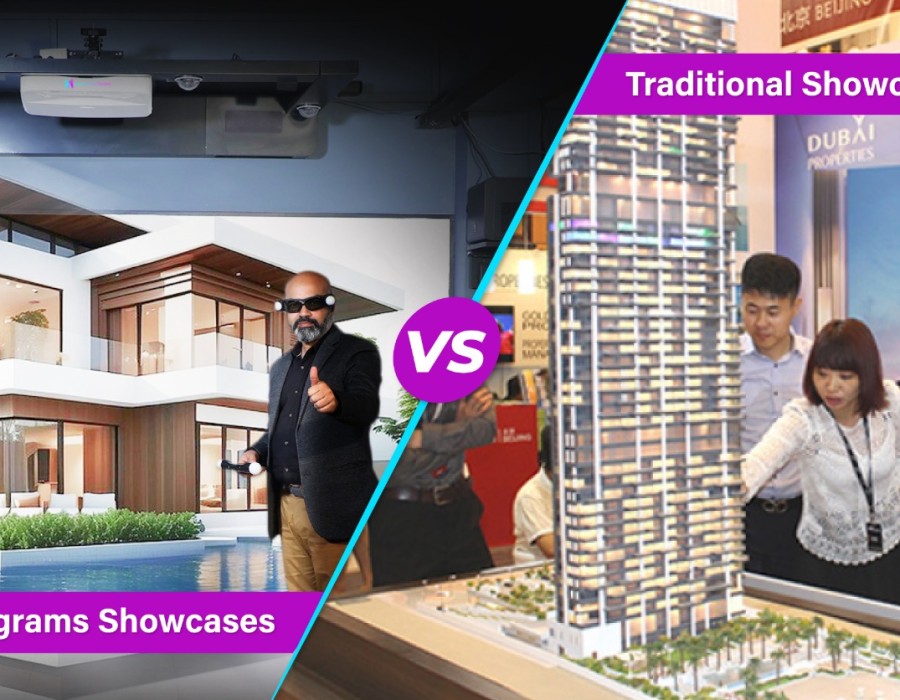The real estate industry is constantly evolving, embracing new technologies to enhance the customer experience. While traditional property showcases have served their purpose, they come with limitations. Here at Hypervision Technologies, a leading 3D hologram solutions provider, we're excited to introduce a revolutionary way to showcase properties: 3D Holographic Stage.
This blog will delve into the key differences between traditional showcases and 3D holograms, exploring the benefits and potential drawbacks of each approach. Additionally, we'll address the initial investment associated with 3D holograms (starting at ₹42 Lakh) and demonstrate how it can ultimately save you time, hardware costs, and create a more impactful experience for potential buyers.
The Traditional Showcase: A Familiar Friend
Traditional property showcases rely on physical tours and static visuals. This includes:
Physical Tours: Potential buyers walk through the property, guided by a real estate agent. This method offers a firsthand experience, but limitations exist. Scheduling conflicts, travel time for distant properties, and difficulty visualizing potential layouts are all common hurdles.
Static Visuals: Photographs and brochures offer a glimpse into the property, but lack the ability to showcase spatial relationships and details.
While traditional methods have their place, they can feel outdated and fail to cater to the modern, tech-savvy buyer.
Enter the Future: 3D Holographic Displays
3D Holographic Displays offer a transformative way to showcase properties. Imagine a miniature, three-dimensional model of the property floating in mid-air, allowing viewers to interact with it in real-time. Here's what sets them apart:
Immersive Experience: 3D holograms create a captivating and interactive experience. Viewers can walk around the holographic model, zoom in on specific features, and even see different design options within the same space. This fosters a deeper understanding of the property's layout, flow, and potential.
Remote Accessibility: Imagine showcasing a property under construction or located in another city. With 3D holograms, potential buyers can explore the property remotely, saving valuable time and resources. This opens doors to a wider audience and eliminates geographical limitations.
Enhanced Visualization: 3D holograms allow for the integration of furniture, décor, and virtual staging. Potential buyers can envision themselves living in the space, fostering a stronger emotional connection to the property.
Interactive Features: Imagine showcasing a property with interactive elements. Viewers can tap on the hologram to access additional information about specific features, like floor plans, amenities, and even virtual tours for a more comprehensive experience.
Addressing the Cost: A Long-Term Investment
The initial investment for a 3D Holographic Stage system (starting at ₹42 Lakh) might seem substantial compared to traditional showcases. However, consider these factors:
Reduced Travel Expenses: 3D holograms eliminate the need for constant physical tours. This saves time and money spent on travel, especially for showcasing properties in different locations.
Increased Efficiency: Agents can showcase multiple properties to a wider audience simultaneously, maximizing their productivity and lead generation.
Reduced Printing Costs: With 3D holograms, the need for printed brochures and photographs significantly decreases, reducing printing and distribution costs.
Long-Term Use: 3D holographic displays are durable and can be used for various properties over an extended period. This spreads the initial investment across multiple projects, maximizing its return.
Beyond 3D Holograms: Exploring AR/VR
Augmented Reality (AR) and Virtual Reality (VR) are also emerging technologies with applications in real estate. AR overlays digital elements onto the real world, while VR creates a fully immersive digital environment. These technologies offer unique benefits but also have limitations:
AR: AR apps can be used for virtual staging, allowing buyers to visualize furniture and décor within the actual property space. However, AR experiences can be limited by a user's smartphone or tablet screen size.
VR: VR headsets immerse users in a fully digital recreation of the property. While incredibly immersive, VR experiences require specialized equipment and can be cumbersome for users.
3D Holograms vs. AR/VR: Finding the Right Fit
While AR and VR offer exciting possibilities, they currently face limitations in terms of accessibility and user experience. 3D Holograms provide a more user-friendly and accessible solution. They don't require specialized equipment and offer a collaborative viewing experience for multiple users.
Conclusion: A Bold Step into the Future
3D Hologram technology represents a paradigm shift in real estate marketing. It offers an immersive, interactive, and time-saving way to showcase properties. While the initial investment is higher.





Comments